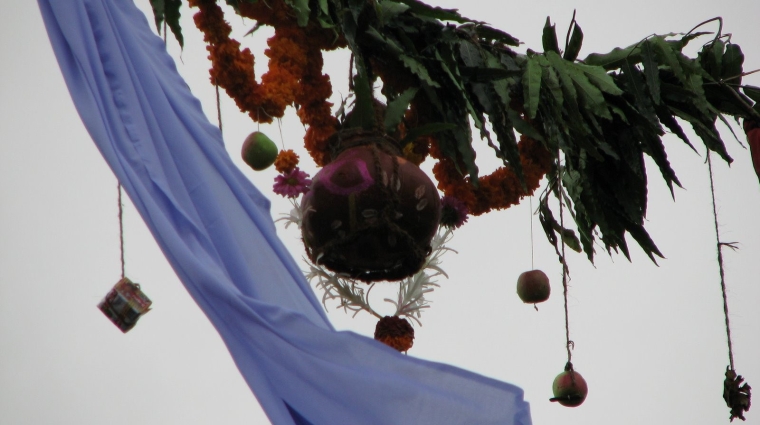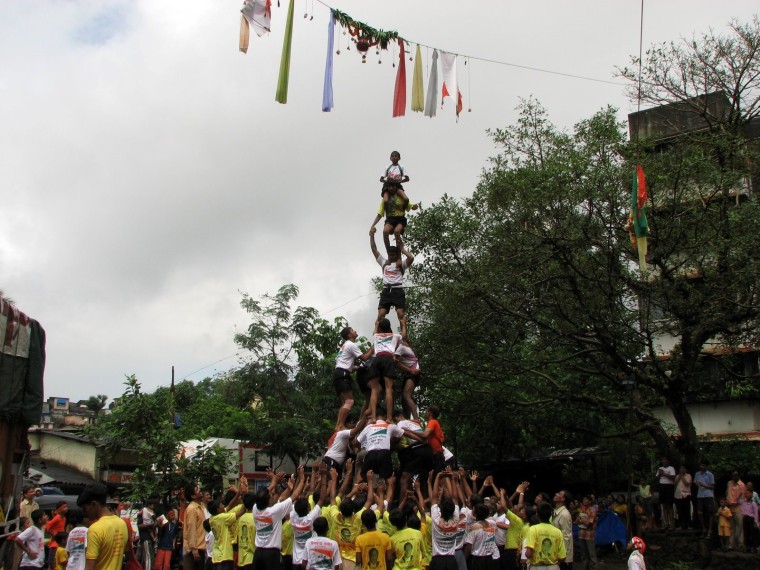Shachi Phadke
While the rest of India focuses on the midnight festivities of Krishna Janmashtami, or the birth of Lord Krishna, Mumbai focuses instead on the next day, when the celebrations of Dahi Handi take place.
Dahi Handi, now a cross between religious festival and a team sport, involves a group of mostly young men creating a human pyramid, up to eight or nine layers tall, in order to reach and break an earthen pot or Handi, to get at the sweet yogurt or Dahi that it is filled with. The first team of young men or women to reach and break open the Dahi Handi, is awarded the prize money for each such feat. The higher the Handi is placed, more the prize money awarded. This contest now leads the whole of Mumbai to participate in the festival where Dahi Handis are placed higher and higher each year.

Dahi Handi does try and evoke the idea of young Krishna, whose natkhat or naughty disposition led to gathering his friends from the village where he was growing up, making human pyramids with them, and reaching and eating the yogurt and butter hung up high in earthen pots, with the sole purpose of keeping it out of the hands of little kids such as himself. This festival, calling upon the young and playful persona of the deity rather than the more popular warrior or philosopher persona, has been a major part of the city’s landscape of public religious festivals and it certainly gives it a boisterous character.
The Govinda is a moniker used for the young men who participate in the human pyramid, and also is another name for Lord Krishna and so is rather appropriate. The Govindas start very early on the day after the Krishna’s Janm or birth, which gets celebrated at midnight. They have been practicing months ahead of time in order to participate. The Govindas gather in the morning and get ready to go to a few of the Dahi Handis in and around their neighbourhood, and if they are really good, to go far and wide to gather the prize money. The loud rhythm of Dhols or Nashik drums follows them around. They start with their own Handi, in their locality and their neighborhood, where a crowd gathers to cheer them on. Usually, it rains. This is slap bang in the middle of the monsoon, so the pitter-patter of warm rain helps to keep the Govinda’s cool while they make the pyramid as tall as they can. If the rain is not around that year, and there has been no drought, then the locals would throw buckets of water on them. It feels like it’s rude. It isn’t. It’s actually part of the fun. In the chants and calls of the Govindas, which they sing and call out while raising the pyramid; there tend to be ones specifically asking for water along with the cheers. For instance, check out the song Govinda Re Gopala from the 1991 Marathi movie Hamal De Dhamal
The Hindi and Marathi movie industries which are based out of Mumbai do tend to jump on the Dahi Handi bandwagon. In the 1963 Shammi Kapoor starrer, Bluff Master, for example, the song Govinda Aala Re Aala became a classic. The festival is used often times to show the natkhat hero, impressing his heroine or to establishing himself as one of the common folk, going around breaking the Handis. In Mach Gaya Shor Sari Nagri, for instance, Amitabh Bachchan is the natkhat hero. Despite the unrealistically hefty hero being the top-most layer of the Govindas and the breaker of the Handi, the honour is normally reserved for the littlest of the lot. These songs will be played over and over again by the band and the dhol pathaks which accompany the Govindas all day.
The smallest of the Govindas, usually a skinny pre-teen, is the one on top of the pyramid and will actually break the Handi, as he/she is the representative of little Lord Krishna as well as the lightest weight for the rest of the pyramid to bear. A crowd of their squad surrounds the Govindas for encouragement and dance very ungracefully on the beat of the dhol. They are also the buffer layer that will catch the Govindas incase their pyramid fails and they all tumble to the ground. Each team gets three tries to get to the Handi and claim their prize. If the troupe is indeed successful, the prizes gathered during the day get distributed amongst the Govindas, your share depending on your position within the pyramid. Sometimes they come back bruised and injured, their tumble being too hard. The more the risks you took the more the prizes and also the more the falls. With increasing prize money and risks, governmental bodies have been trying to lay some rules, trying to set a minimum age of participation, limit the number of layers allowed as well as total height of the pyramid; and the highest courts of the land are trying to debate the matter, contemplating tradition and safety.

As one of the most visually striking festivals and communal sporting activities within the city, the Dahi Handi starts off the festival season in the Hindu religious calendar in Mumbai, starting the city off on the upcoming hullabaloo which will take us over on the beat of the dhols.
Shachi is a dyed-in-the wool Mumbai lover who wanders the streets of Mumbai aimlessly. In her free time, she works in the development sector.
